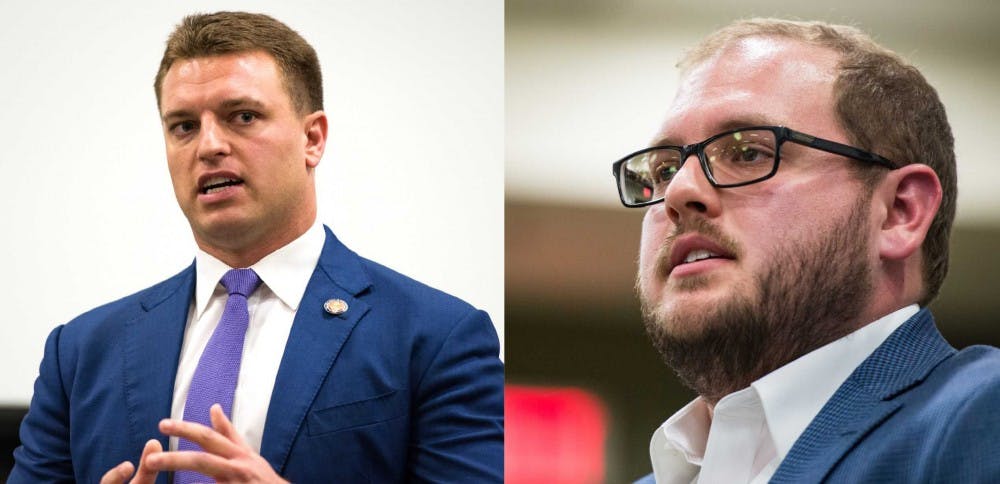Jay Edwards and Taylor Sappington participated in a civil and rarely contentious debate at Ohio University on Monday that focused on who will best represent Southeast Ohioans.
The questions posed by moderator DeLysa Burnier, a professor of Political Science at Ohio University, spotlighted major issues such as campaign finance, abortion, poverty, State Issue 1 and infrastructure.
Sappington, the Democratic candidate, spent much of the debate directing criticism not to Edwards, the Republican incumbent, but instead to the Ohio Statehouse, which is currently held by a Republican supermajority. Ohio Republicans also hold every state office and hold a majority on the Ohio Supreme Court based on the state party nominations of justices prior to the nonpartisan general elections.
When both candidates were asked about what policies they would support to help impoverished people from Southeast Ohio, Sappington said he would support various initiatives such as hiking the minimum wage, reforming education and reducing college tuition by putting surplus tax dollars to work.
“The Statehouse can do that and a supermajority statehouse can do that today … but they haven’t,” Sappington said. “This is one of the reasons I am running, because we can see what they care about in Columbus and I’d like to inject new ideas.”
Edwards said they have to look at ways to increase opportunity by combating the opioid epidemic and get more people into higher education by making it affordable. He said that being a member of the Appalachian Caucus in the Statehouse sets him apart from the rest of the Republicans because he has to work to represent the interests of this region rather than big cities like Columbus, Cleveland or Cincinnati.
“We are working on many projects right here in this region both across the aisle and with fellow Republicans to figure out poverty issues and address them,” Edwards said.
The candidates were asked multiple times how they would seek funds for infrastructure projects, improvement of rural broadband and providing funding to local governments. Sappington was in favor of using the rainy day fund for these projects, while Edwards was against it.
Sappington said he believes rural broadband should be a public utility rather than something regulated by private corporations. He said the $2.7 billion in Ohio’s rainy day fund should be used to projects like these in addition to other things.
“Everyone just wants these damn potholes to go away,” Sappington said.
Edwards said that it is OK to save money and have a rainy day fund and the money saved up in this fund should only be used in the case of an economic crisis. Edwards agreed that they should find other ways to fund it, but cautioned restraint on spending.
“I know many of you probably go out on a Saturday night. I don’t think you’ll want to spend all the funds in your bank and max out your credit card right before you went uptown,” Edwards said. “It’d make for a pretty boring Saturday night.”
Both candidates are graduates of Ohio University, and the conversation eventually turned to the issue of college affordability. Burnier asked the candidates how they would reduce the cost of attending a public university.
Edwards said that he wants to see an increase in need-based grants and scholarships among colleges and universities. He said that even though Ohio is ranked 45 out of 50 among states for college affordability, he is proud that tuition growth has remained stagnant due to programs such as the OHIO Guarantee at OU.
Sappington took a different approach and said that those increases are rooted in how the state government has reduced funding to state colleges.
“As they have cut taxes in the Statehouse over the last 8 years and they have cut the budget for higher education, they have the nerve to say they don’t know what to do,” Sappington said. “We have to talk about what changed in Columbus and how to change it back.”
The candidates were asked how they would work across the aisle and promote bipartisanship within the state legislature and if they have views on issues that they are not in line with their party on.
Sappington did not give any specific examples of right leaning positions he may have, but he said there are a variety of issues that will receive bipartisan support.
“You have to work on issues like infrastructure, like broadband expansion where there is broad agreement,” Sappington said. “We can work on these things together.”
Edwards said he is very supportive of workers unions, something that is seen as traditionally Democratic. He talked about how numerous local and statewide labor unions have endorsed his campaign over Sappington’s.
“I don’t spend a lot of time thinking about bills and whether they are Democrat or Republican,” Edwards said. “I like to base my views on right or wrong rather than right or left.”
Through the rest of the debate the candidates disagreed on party lines about abortion, campaign finance, the Electronic Classroom of Tomorrow (ECOT) and State Issue 1.






